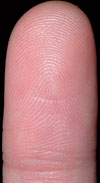

The Council for Scientific and Industrial Research’s (CSIR) Modelling and Digital Science (MDS) Unit has developed a new fingerprint classification and recognition technique.
The project by the MDS (the new generation of young men and women trying to establish themselves as researchers, scientists and engineers) started back in 2008 and was completed in 2011.
Hi-Tech Security Solutions spoke to the researcher who developed the new technology, Ishmael Msiza.
The group
“I joined CSIR’s biometrics research group of MDS in April 2008. We started working on this project four years ago with a very small group consisting of three individuals, myself, Patric Khaile and Dick Mathekge,” says Msiza. “We had strict deadlines and pressure to deliver.
“Mathekge completed the project with us and he is currently doing his PhD studies at Cambridge University in the UK. We have also managed with the help of fourth-year students from different universities who assisted during the course of this project.”
The idea of the project was to develop an identity authentic system. “We chose the fingerprint because it is less evasive, it is generally accepted and it is the most accurate as a biometric,” Msiza continues. “It is the most reliable, compared to a password, as a biometric security mechanism.
“The structural fingerprint classifier is able to correctly classify a fingerprint with only partial information. Whereas passwords can be compromised and used by different individuals who have access to it.”
New vs. old
The new technology is efficient, fast, accurate and cost effective. For example, the re-enrolments at the department of home affairs can be done without bringing in individuals for manual fingerprinting. They can take all copies of prints done on paper and scan them efficiently, faster and accurately. The old technology is inefficient, slow, inaccurate and costly. Huge sums of money can be lost on manual re-enrolments that can also be time consuming and result in problems due to poor administration.
“There are conventional techniques that exist for fingerprint identity authentication,” he explains. “In this instance we have raised the bar and developed novel features to speed up the recognition of fingerprints. This renders the new structural technique faster as it breaks down the overall database into smaller chunks to improve the performance of the fingerprint recognition system.”
In the old fingerprint recognition system, the templates usually sat in a database. When doing an identification process, thousands of templates had to be sifted through. This slowed down the process. With the new structural fingerprint features, the scanner can pick up and capture the lapped or rolled fingerprint’s turning point known as the core, or the side of the fingerprint known as the delta and make an identification. A rolled fingerprint is highly unlikely to miss the core and less likely to miss the delta, says Msiza.
Security efficiency
It was a meticulous process in determining the security efficiency of the new technique. The CSIR data network and security group ran tests on the new structural technique technology and confirmed that it is user friendly and effective. They ensured that each and every module was tested using a confusion matrix. To enhance security, its algorithms are standardised and encrypted.
On international testing standards, it is rated 86% secure, while on the locally collected database done by David Braude (Masters Wits, PhD University of Ireland) it is rated 80,4% secure, Msiza notes.
The CSIR is currently putting the package together for the market. CSIR is also in licensing negotiations with some of the companies that will distribute the new technique. “We regret that at this stage we cannot name the companies due to contractual restrictions,” says Msiza. “We are not a profit driven institution. Our task is to discover and advance new technology for the future through science.”

© Technews Publishing (Pty) Ltd. | All Rights Reserved.